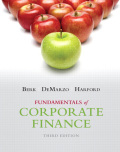
Longer-term bonds:
Bonds with long maturity period are called as longer-term bonds. These bonds carry high risk because an alteration in the interest rate or probability of higher inflation in the economy over a longer period can reduce
Shorter term bonds
Bonds with short maturity period are called as shorter-term bonds. Short duration reduces the risk as well as interest rates on these bonds. An investor who aims to earn the profit between the redemption value and investment cost will invest in shorter-term bonds.
Interest rate
The interest rate is simply the rate at which annual coupon payment is made by the issuer of a bond. The rate is set at the time of issue of the bond and the same rate is mentioned in the bond certificate.
To determine:
The sensitivity of longer-term bonds in comparison to shorter-term bonds with changes in interest
Want to see the full answer?
Check out a sample textbook solution
Chapter 6 Solutions
EBK FUNDAMENTALS OF CORPORATE FINANCE
- Stock rises from $80 to $100. % Increase?A) 20% B) 25% C) 15% D) 10%arrow_forwardFinance question 7. A person buys a stock for $100 and sells it for $120. What is the gain?A) $10B) $20C) $25D) $15arrow_forwardFinance question 7. A person buys a stock for $100 and sells it for $120. What is the gain?A) $10B) $20C) $25D) $15arrow_forward
- A person buys a stock for $100 and sells it for $120. What is the gain?A) $10B) $20C) $25D) $15arrow_forwardi need help!! If you invest $1,000 at 10% compound interest for 1 year, the amount is:A) $1,100B) $1,050C) $1,200D) $1,000arrow_forwardIf you invest $1,000 at 10% compound interest for 1 year, the amount is:A) $1,100B) $1,050C) $1,200D) $1,000arrow_forward
- I need help!! A loan of $5,000 at 6% interest for 2 years gives what simple interest?A) $600B) $500C) $300D) $200arrow_forwardA loan of $5,000 at 6% interest for 2 years gives what simple interest?A) $600B) $500C) $300D) $200arrow_forwardDear expert i need answer in this question!! What does ROI stand for in finance?A) Return on InvestmentB) Rate of InterestC) Revenue on IncomeD) Return on Insurancearrow_forward
 Essentials Of InvestmentsFinanceISBN:9781260013924Author:Bodie, Zvi, Kane, Alex, MARCUS, Alan J.Publisher:Mcgraw-hill Education,
Essentials Of InvestmentsFinanceISBN:9781260013924Author:Bodie, Zvi, Kane, Alex, MARCUS, Alan J.Publisher:Mcgraw-hill Education,

 Foundations Of FinanceFinanceISBN:9780134897264Author:KEOWN, Arthur J., Martin, John D., PETTY, J. WilliamPublisher:Pearson,
Foundations Of FinanceFinanceISBN:9780134897264Author:KEOWN, Arthur J., Martin, John D., PETTY, J. WilliamPublisher:Pearson, Fundamentals of Financial Management (MindTap Cou...FinanceISBN:9781337395250Author:Eugene F. Brigham, Joel F. HoustonPublisher:Cengage Learning
Fundamentals of Financial Management (MindTap Cou...FinanceISBN:9781337395250Author:Eugene F. Brigham, Joel F. HoustonPublisher:Cengage Learning Corporate Finance (The Mcgraw-hill/Irwin Series i...FinanceISBN:9780077861759Author:Stephen A. Ross Franco Modigliani Professor of Financial Economics Professor, Randolph W Westerfield Robert R. Dockson Deans Chair in Bus. Admin., Jeffrey Jaffe, Bradford D Jordan ProfessorPublisher:McGraw-Hill Education
Corporate Finance (The Mcgraw-hill/Irwin Series i...FinanceISBN:9780077861759Author:Stephen A. Ross Franco Modigliani Professor of Financial Economics Professor, Randolph W Westerfield Robert R. Dockson Deans Chair in Bus. Admin., Jeffrey Jaffe, Bradford D Jordan ProfessorPublisher:McGraw-Hill Education





